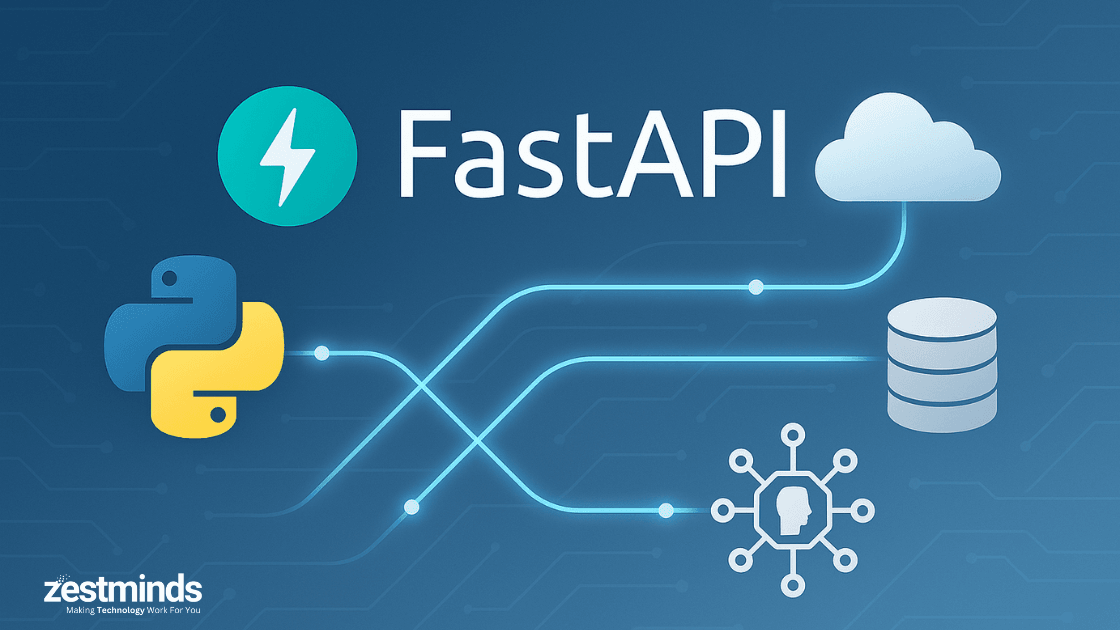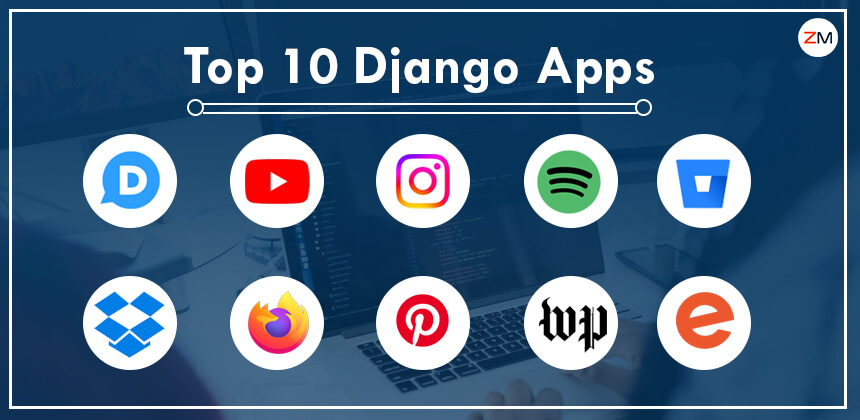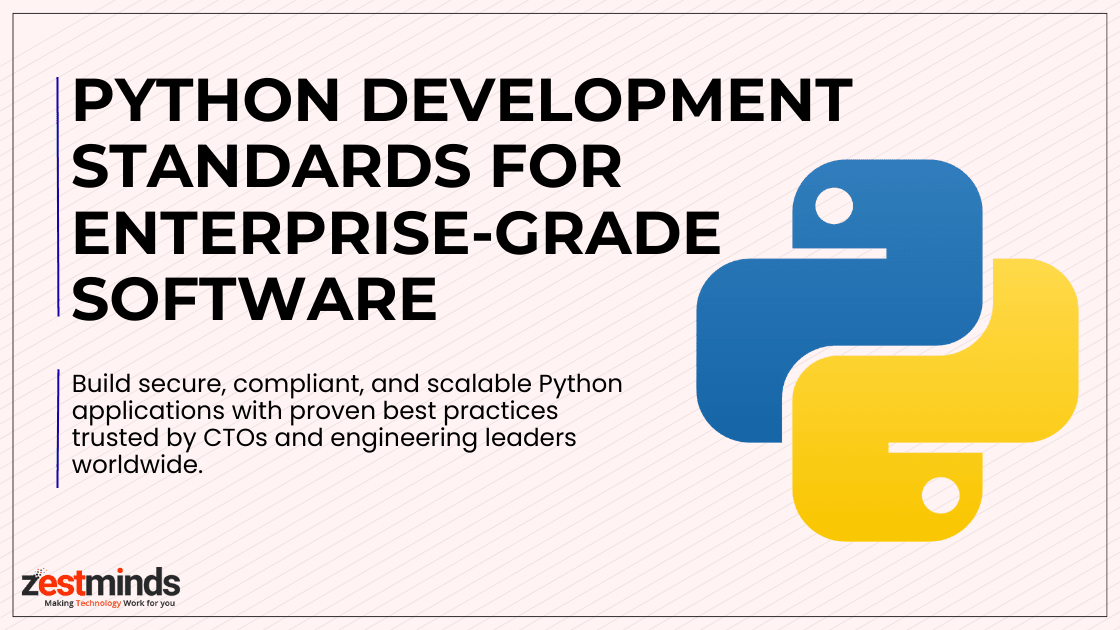FastAPI Requirements & Setup Guide (2025): The Complete Developer Handbook
FastAPI setup in 2025 is all about speed, structure, and smarter automation. From Python environment setup to requirements.txt optimization and Docker deployment, this guide walks developers through a proven, production-ready workflow. Perfect for backend teams building high-performance APIs that scale with AI and microservices – powered by Zestminds.

Introduction
FastAPI is how modern developers turn Python code into production-grade APIs — fast, secure, and beautifully documented. Whether you’re building microservices, AI workflows, or full-scale SaaS backends, this handbook walks you through everything — from fastapi requirements.txt to real-world deployment. Think of it as your FastAPI launch checklist for 2025.
By the end, you’ll know how to:
- Set up a clean FastAPI development environment
- Build async APIs that perform like C-class engines
- Structure production-ready projects that scale
- Auto-generate docs your PMs will actually read
- Deploy confidently with Docker and Uvicorn
Zestminds has helped startups and enterprises worldwide design and deploy lightning-fast backends using FastAPI — and this is exactly how we do it.
Why FastAPI Still Dominates Python Backend Development in 2025
FastAPI isn’t a trend — it’s the backbone of modern Python development. In 2025, it remains one of the top three most-used Python web frameworks, known for its async speed, Pydantic validation, and type-safe architecture.
FastAPI vs Flask vs Django (2025 Edition)
If Flask is your reliable sedan and Django a fully loaded truck, FastAPI is the Tesla — smooth, fast, and smart under the hood. It merges Flask’s simplicity with Django’s robustness and adds async horsepower on top.
- Auto-generated documentation: OpenAPI + Swagger built in
- Type hints and validation: Powered by Pydantic
- Async performance: Handles thousands of concurrent requests
- Enterprise-ready speed: Benchmarked among the fastest Python frameworks (TechEmpower)
In short: FastAPI saves time, reduces bugs, and helps teams deliver APIs that just work — beautifully.
Step-by-Step FastAPI Setup Example (2025)
FastAPI feels like regular Python — just turbo-charged. You write functions, and it takes care of routing, validation, and docs. It’s like driving an automatic car that still gives you manual control when you need it.
from fastapi import FastAPI
app = FastAPI()
@app.get("/")
async def home():
return {"message": "FastAPI is blazing fast!"}
That’s it — your first async endpoint. And yes, it auto-generates an OpenAPI schema instantly.
Want to scale beyond the tutorial? Explore how Zestminds builds production-grade APIs at FastAPI Development Services.
System & Python Requirements for FastAPI (2025 Update)
Before building your first endpoint, make sure your foundation is solid. FastAPI thrives on clean environments and updated dependencies.
Python, PIP & Environment Setup Checklist
Recommended versions for 2025:
- Python 3.10+ (ideally 3.12)
- pip upgraded to latest
- Virtual environment active
Basic setup:
python3 -m venv venv
source venv/bin/activate # Mac/Linux
venv\Scripts\activate # Windows
Then create your requirements.txt file:
# fastapi requirements.txt
fastapi==0.115.0
uvicorn==0.30.0
pydantic==2.7.0
python-dotenv==1.0.1
requests==2.31.0
Install dependencies:
pip install -r requirements.txtThis ensures every teammate or CI server runs the same setup — no “it works on my laptop” issues.
Installing FastAPI + Uvicorn
FastAPI runs on the ASGI standard. Uvicorn is the most popular ASGI server.
pip install fastapi uvicorn
uvicorn main:app --reload
Quick fix guide:
- ModuleNotFoundError: Forgot to activate venv or install dependencies.
- Port conflict: Use
--port 8081. - Encoding issues (Windows): Set
PYTHONUTF8=1.
Need a pre-configured boilerplate? See our AI-ready example in Build AI Workflows with FastAPI & LangGraph.
FastAPI Project Setup: From Folder Structure to Hello World
Great projects don’t start messy. A strong structure saves time when scaling your API across modules or teams.
Folder Structure Best Practices (2025)
fastapi_app/
├── app/
│ ├── main.py
│ ├── routers/
│ ├── schemas/
│ ├── services/
│ └── core/
├── tests/
├── requirements.txt
└── .env
This layout mirrors production-grade architectures we use at Zestminds — modular, readable, and microservice-ready.
Main.py Setup + Async Endpoint Demo
from fastapi import FastAPI
from routers import users
app = FastAPI(title="Zestminds FastAPI Example")
app.include_router(users.router)
Router example:
from fastapi import APIRouter
router = APIRouter(prefix="/users")
@router.get("/")
async def get_users():
return [{"name": "John"}, {"name": "Sara"}]
Visit /docs — your API now comes with auto-generated Swagger UI. That’s FastAPI’s hallmark: minimal code, maximum impact.
Testing Locally with Uvicorn
from fastapi.testclient import TestClient
from app.main import app
client = TestClient(app)
def test_home():
response = client.get("/")
assert response.status_code == 200
At Zestminds, automated testing helped our Easy Marketing App API maintain 99.8% uptime across continuous releases.
Core FastAPI Features Every Developer Should Master
FastAPI’s superpower lies in its design — less boilerplate, more business logic. Here are the essentials every developer should know.
Pydantic Models & Validation
Pydantic lets you define models once and forget about manual validation. It’s like having a gatekeeper for your API inputs.
from pydantic import BaseModel
class User(BaseModel):
name: str
email: str
FastAPI automatically checks types and formats before execution — saving hours of debugging time.
Async Endpoints & Performance Boost
Async functions let your API handle multiple requests simultaneously — perfect for I/O-heavy workloads like AI inference or third-party APIs. That’s how we build FastAPI-based ML inference layers that serve millions of requests per month.
OpenAPI & Auto-Generated Docs
No need to maintain separate documentation. FastAPI automatically generates Swagger and Redoc UIs. Open /docs or /redoc — and share them directly with clients or testers.
FastAPI Deployment: From Localhost to Cloud (Docker, Uvicorn, Gunicorn)
Deployment doesn’t have to be scary. With Docker, you can ship your API anywhere — AWS, GCP, or your laptop — with identical results.
Dockerizing Your FastAPI App
# Dockerfile
FROM python:3.12
WORKDIR /app
COPY requirements.txt .
RUN pip install -r requirements.txt
COPY . .
CMD ["uvicorn", "app.main:app", "--host", "0.0.0.0", "--port", "8000"]
Build and run:
docker build -t fastapi-app .
docker run -p 8000:8000 fastapi-app
Pro tip: Use Docker Compose or GitHub Actions for automated builds — the same CI/CD workflows we use across Zestminds client deployments.
Running with Uvicorn + Gunicorn
gunicorn -k uvicorn.workers.UvicornWorker app.main:app -w 4 -b 0.0.0.0:8000
This hybrid setup takes full advantage of multi-core CPUs for production scalability.
Environment Variables & CI/CD Pipelines
Use .env files for configuration — never hardcode secrets. Example:
DATABASE_URL=postgres://user:password@host/db
Then load it via python-dotenv:
from dotenv import load_dotenv
load_dotenv()
Integrate your tests, linting, and deploy steps via GitHub Actions or GitLab CI. Zestminds teams frequently deploy FastAPI apps to AWS ECS, GCP Cloud Run, or Azure Containers.
Performance, Security & Best Practices (2025 Edition)
from fastapi.security import OAuth2PasswordBearer
oauth2_scheme = OAuth2PasswordBearer(tokenUrl="token")
@app.get("/profile")
async def profile(token: str = Depends(oauth2_scheme)):
return {"message": "Authenticated"}
Combine OAuth2 with JWTs for robust authentication. Add HTTPS and CORS rules before production launch.
Takeaway: Speed is nothing without security. Logging, validation, and proper error handling turn a FastAPI project into an enterprise-ready product.
Profiling Async Performance
Tools like PyInstrument or async-profiler help track latency. At Zestminds, we benchmark each endpoint’s response time under real-world loads to ensure clients hit 99th percentile SLAs.
Error Handling & Logging Patterns
@app.middleware("http")
async def log_requests(request, call_next):
response = await call_next(request)
print(f"{request.method} {request.url} → {response.status_code}")
return response
Use structured logging for production – it’s the first step toward observability.
Need a performance audit or API security review? Book a free consultation with Zestminds.
Integrating FastAPI with AI & Microservices (Future-Ready APIs)
FastAPI isn’t limited to CRUD – it’s powering the new AI wave. Zestminds engineers frequently integrate FastAPI with OpenAI, LangGraph, and Weaviate to orchestrate large-scale data and inference pipelines.
Example: Our AI Kitchen Planner project combined FastAPI with OpenAI and Weaviate, handling 10M+ API calls monthly — all on async I/O.
Ready to modernize your stack? Talk to our FastAPI team and let’s build something future-proof together.
Conclusion
FastAPI is the Python developer’s secret weapon for 2025. It’s simple, async, and production-ready out of the box. Whether you’re running a startup or scaling enterprise systems, it gives you speed without sacrificing structure.
You now know how to configure your fastapi requirements.txt, design modular architectures, and deploy globally. The next step? Build, ship, and scale with confidence.
Imagine launching your API in half the time. Zestminds helps teams worldwide build scalable backends, optimize performance, and integrate AI using FastAPI. Let’s build your next big thing →
Quick Recap
- FastAPI setup starts with Python 3.12 and a clean requirements.txt.
- Use async, Pydantic, and auto-docs to simplify workflows.
- Docker + Uvicorn make deployment easy and repeatable.
- Secure it with JWT, profiling, and logging middleware.
FAQs
What are the minimum system requirements for running FastAPI in 2025?
Python 3.10+ (ideally 3.12), pip, and an ASGI server like Uvicorn. Works across Windows, macOS, and Linux.
How do I install and test a FastAPI app locally?
Create a venv, install fastapi and uvicorn, run uvicorn main:app --reload, and visit /docs.
Which is better for modern Python APIs — FastAPI or Flask?
FastAPI wins for async performance, type hints, and built-in validation. Flask remains great for simpler, synchronous apps.
How do I deploy FastAPI using Docker?
Include dependencies in requirements.txt, add a Dockerfile, and run uvicorn or gunicorn inside the container.
What’s the best FastAPI project structure for 2025?
Follow the modular layout: app/main.py, routers/, schemas/, services/, and a root-level requirements.txt.
Can FastAPI power AI or microservices?
Yes — it’s async, modular, and integrates smoothly with LangGraph, OpenAI, and vector databases like Weaviate.
Is FastAPI secure for enterprise workloads?
Absolutely. With proper JWT/OAuth2, HTTPS, and CORS setup, it’s robust enough for fintech, healthtech, and SaaS deployments.
What’s in a typical fastapi requirements.txt file?
Core packages: fastapi, uvicorn, pydantic, python-dotenv, and optional libraries like sqlalchemy or httpx.
Table of Contents
- Introduction
- Why FastAPI Still Dominates Python Backend Development in 2025
- System & Python Requirements for FastAPI (2025 Update)
- FastAPI Project Setup: From Folder Structure to Hello World
- Core FastAPI Features Every Developer Should Master
- FastAPI Deployment: From Localhost to Cloud (Docker, Uvicorn, Gunicorn)
- Performance, Security & Best Practices (2025 Edition)
- Integrating FastAPI with AI & Microservices (Future-Ready APIs)
- Conclusion
- FAQs

Rajat Sharma
About the Author
With over 8 years of experience in software development, I am an Experienced Software Engineer with a demonstrated history of working in the information technology and services industry. Skilled in Python (Programming Language), PHP, jQuery, Ruby on Rails, and CakePHP.. I lead a team of skilled engineers, helping businesses streamline processes, optimize performance, and achieve growth through scalable web and mobile applications, AI integration, and automation.
Stay Ahead with Expert Insights & Trends
Explore industry trends, expert analysis, and actionable strategies to drive success in AI, software development, and digital transformation.


